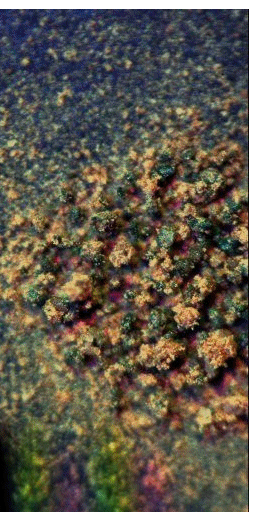It looks like you're using an Ad Blocker.
Please white-list or disable AboveTopSecret.com in your ad-blocking tool.
Thank you.
Some features of ATS will be disabled while you continue to use an ad-blocker.
1
share:
Here’s something very interesting that I want to share with you guys. I received this in my email – an animation of microscopic images from Sol
112.
Launched in August 2007, the Phoenix Mars is designed to study the history of water and habitability potential in the Martian soil. Analysis of the data may provide important answers to the age old question – Can the Martian arctic support life?
For this, Phoenix uses some of the most sophisticated and advanced technology ever sent to Mars incliding a MECA Microscope that includes Optical and Atomic Force microscopes. What did it find?
Here’s a one second continuous loop animated image I received…
Anim Courtesy: Stuart Atkinson and
ElkGroveDan of Unmannedspaceflight
Notice the movement of the ‘dust grains’ seen in several different close-ups of the same pile of dust. Are these dust particles being disturbed due to wind? But wind inside the OM? Unlikely. Or could it be due to some magnetic effects on the particles or vibrations of the motors that are making them move? Notice that particles outside the 'square' do not show any 'movement'. Lastly, could they be living organisms? I personally feel it could be due to vibration. But all said and done, this is pretty fascinating!
It would be great if you guys can figure this out as I’m no astrobiologist or an expert in MECA microscopy!!
Cheers!
phoenix.lpl.arizona.edu...
phoenix.lpl.arizona.edu...
phoenixpics.wordpress.com...
Launched in August 2007, the Phoenix Mars is designed to study the history of water and habitability potential in the Martian soil. Analysis of the data may provide important answers to the age old question – Can the Martian arctic support life?
For this, Phoenix uses some of the most sophisticated and advanced technology ever sent to Mars incliding a MECA Microscope that includes Optical and Atomic Force microscopes. What did it find?
Here’s a one second continuous loop animated image I received…
Anim Courtesy: Stuart Atkinson and
ElkGroveDan of Unmannedspaceflight
Notice the movement of the ‘dust grains’ seen in several different close-ups of the same pile of dust. Are these dust particles being disturbed due to wind? But wind inside the OM? Unlikely. Or could it be due to some magnetic effects on the particles or vibrations of the motors that are making them move? Notice that particles outside the 'square' do not show any 'movement'. Lastly, could they be living organisms? I personally feel it could be due to vibration. But all said and done, this is pretty fascinating!
It would be great if you guys can figure this out as I’m no astrobiologist or an expert in MECA microscopy!!
Cheers!
phoenix.lpl.arizona.edu...
phoenix.lpl.arizona.edu...
phoenixpics.wordpress.com...
The samples are positioned on a wheel which holds 60 samples. The samples are "stuck" to a sticky silicone coating. The wheel sits on a stage which
moves in order to focus the image.
Click the image to see the whole apparatus.
Source
It looks like that's what's happening here. The larger particles, which may not be very well stuck to the sticky substrate, move a bit when wheel and/or stage moved between shots.
[edit on 27-9-2008 by Phage]
Click the image to see the whole apparatus.
Particles can sometimes move as a result of the stage motion (as in Figure 3), so it is not sufficient just to subtract the two images. In at least one case, the substrate itself rotated between images.
Source
It looks like that's what's happening here. The larger particles, which may not be very well stuck to the sticky substrate, move a bit when wheel and/or stage moved between shots.
[edit on 27-9-2008 by Phage]
Originally posted by Phage
The samples are positioned on a wheel which holds 60 samples. The samples are "stuck" to a sticky silicone coating. The wheel sits on a stage which moves in order to focus the image.
Click the image to see the whole apparatus.
Particles can sometimes move as a result of the stage motion (as in Figure 3), so it is not sufficient just to subtract the two images. In at least one case, the substrate itself rotated between images.
Source
It looks like that's what's happening here. The larger particles, which may not be very well stuck to the sticky substrate, move a bit when wheel and/or stage moved between shots.
[edit on 27-9-2008 by Phage]
Damn I love it when you appear in a thread and law down the truth.
Keep fighting the good fight. Thanks for your dedication to this forum also.
new topics
-
An Interesting Conversation with ChatGPT
Science & Technology: 3 hours ago
top topics
-
Have you noticed?? Post Election news coverage...
World War Three: 16 hours ago, 12 flags -
Squirrels becoming predators
Fragile Earth: 15 hours ago, 10 flags -
Drone Shooting Arrest - Walmart Involved
Mainstream News: 13 hours ago, 10 flags -
World's Best Christmas Lights!
General Chit Chat: 13 hours ago, 8 flags -
Can someone 'splain me like I'm 5. Blockchain?
Science & Technology: 14 hours ago, 7 flags -
Labour's Anti-Corruption Minister Named in Bangladesh Corruption Court Papers
Regional Politics: 15 hours ago, 6 flags -
An Interesting Conversation with ChatGPT
Science & Technology: 3 hours ago, 3 flags
1


